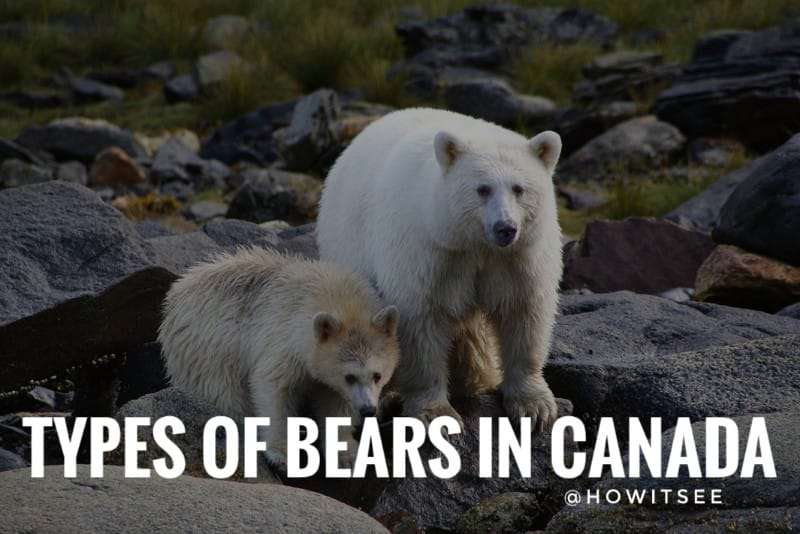Bears are large furry creatures, with a worldwide distribution, mostly in the Northern Hemisphere. Each continent boasts of its endemic bear population, which is of great ecological importance. Among many countries, Canada houses quite a good number of Bear species and has an important role in their conservation. Many people have asked,” What are the different species of Bears found in Canada?” Therefore, in this article titled “Different Types of Bears in Canada: Bear Identification,” we are going to vividly describe the Bear diversity in Canada. So let’s get into our article without much ado.
Types of Bears in the World
1) Polar Bear
2) Grizzly Bear
3) American Black Bear
4) Brown Bear
5) Short-Faced Bear (extinct)
6) Sloth Bear
7) Eurasian Brown Bear
8) Spectacled Bear
9) Sun Bear
10) Tibetan Blue Bear
11) Giant Panda
12) Black Bear
Canada Habitat
Canada is a vast and diverse country with a wide range of habitats that support wildlife. It has fifteen terrestrial and five marine ecosystems, from tundra to arctic ecosystems.
Tundra, boreal forest, grasslands, and temperate deciduous forest are the major biomes of Canada. It is considered the home of 80,000 species of flora and fauna. Canada has over 2 million lakes and 25% of the world’s wetlands.
Canada’s waterways include the Mackenzie River, which drains into the Arctic Ocean, and the St. Lawrence River, which drains the Great Lakes into the Atlantic Ocean.
You can find a lot of species here, from polar bears to racoons to lobsters. Let’s discuss some of the bear species found in Canada.
Types of Bears found in Canada
1) Kermode bear
A quite rare species, the Kermode bears, aka Spirit Bears, occupy the 4th position on our list of Bears in Canada. Kermode bears are a subspecies of the American Black Bear, with roughly 300-500 existing White individuals.
Their body characteristics are quite similar to the American Black Bears, and they follow an omnivorous diet, which shifts to Pacific salmons during autumn.
Kermode Bears are produced from American Black bears due to a recessive white gene that must be present in both the mating individuals.
.How to identify:
- Kermode Bears have the exact traits as American Black bears, except their fur is white, or in some cases develops a slightly brownish hue.
- One can expect a rare sighting of these bears in the Great Bear Rainforest of Canada.
2) Polar bear
Polar bears are the largest existing bear species and also hold the crown for the largest terrestrial carnivore. They are quite strong animals, with males weighing between 400-700 kg and a standing height of 7.1 to 9.1 ft (2.4-5 m).
Females are smaller than males weighing nearly half of males’ body weight. As the name suggests, they are mostly found in the polar ice-capped regions and feed mostly on meat, which covers nearly 70-80% of their diet. Polar bears primarily feed on seals, whales, and other animal carcasses.
How to identify:
- The fur color serves to be the primary identifying feature of Polar bears, where it is mostly white.
- Polar bears have paddle-like paws that help them to swim and survive in ice-capped areas.
- Their neck is elongated, with a comparatively smaller face, with a straight snout. Polar bears have rounded ears.
3) Brown Bear (Grizzly bear)
Brown or Grizzly bears are one of the largest carnivores on the planet. Their body length is somewhere between 1.7 to 2.8 m, and females are slightly smaller, owing to sexual dimorphism.
Grizzly bears have shoulder height in the range of 80-150 cm, which hints to us about their huge bulky body. Their heads are quite large, with an immensely powerful and heavily built skull.
Like other bear species, they too possess claws that are quite large (2-2.5 in) and curved. Grizzly bears occupy tundra regions and coniferous forests in Canada.
How to identify:
- Grizzly bears are one of the largest bear species, and their coat is generally brown.
- These bears have a distinctive hump in their shoulder region, which can help in their quick identification.
- The back is slanting from the hump, and the rump is lower than the shoulders.
- Grizzly bears have rounded ears.
- Their face resembles more like a dish.
4) American Black Bear
With a population of nearly 380,000, the American Black bears are the most common bears that you will encounter in Canada. They are quite large animals with immense muscular powers.
A study has shown adult males weigh anywhere between 70 – 250 kg, and is quite lesser than females, approximately 50-180 kg. They have quite dense, soft fur, which is further divided into two layers.
The underfur is dense, while the outer hairs are long and protective. They occupy forests, swampy areas, and grasslands of Canada.
How to identify:
- As the name suggests, their fur is black, with some specimens showing a dark brownish hue.
- Comparatively smaller than other bear species. They have a straight face profile, and the ruff near the chin is absent.
- Black Bears have pointed ears.
- A hump is absent, and the shoulder is more leveled or flat than other species. Claws are shorter and are more curved or rounded.
What to do when you see a Bear? Safety tips
- Firstly, try all possible to avoid bear encounters. Be careful and pay attention to your surroundings.
- In case you see the animal, make sure to maintain distance, and quietly slide off the place. Bears avoid humans in the first place. So, unless you take the animal by surprise or instigate it in some way or the other, it will maintain its distance.
- In a bear-prone zone, do not carry any food items. Bears have an excellent sense of smell, nearly 100 times better than dogs. Food items can act as excellent bear attractors, so avoid taking them to keep these furry creatures away.
- Avoid any sort of direct eye contact with bears. If you do so, they may perceive you as an opponent and may charge you.
- If you see a bear coming toward you, do not try to run away from it. Bears may seem slow, but they can easily outrun you. Instead, try to stand still and hold your ground. Bears are inquisitive creatures and might come close to taking a sniff. So try to stay calm in as many ways possible.
- Do not try to climb a tree for protection, as bears are excellent tree climbers.
- If you feel that you are about to fall a victim to a bear attack, then check for the bear species first. If it’s a Grizzly bear, then try to play dead. And, in case it is a Black bear, then try to escape and secure a higher position, and try to make yourself look larger.
- If the bear attacks, then try to fight back as a last resort. Hitting on the face and snout might be a temporary relief, and can give you enough time to escape.
Human activities have greatly affected bear populations, and they now stand in a position of worldwide ecological concern. Bears are keystone species in an ecosystem and, therefore, must be protected. Here we end our article on “Different Types of Bears in Canada: Bear Identification.” We will return soon with another article, so stay tuned until then.
Frequently Asked Questions:
Q1) How many types of bears are in Canada?
Four types of bears are found in Canada: American Black Bear, Polar Bear, Kermode Bear, and Grizzly Bear.
Q2) What types of bears does Canada have?
The American Black Bear, Polar Bear, Kermode Bear, and Grizzly Bear are the types of bears found in Canada.
Q3) Does Canada have grizzly bears?
Yes, in Canada, you can find grizzly bears.
Q4) What are the two most common bear species in Canada?
The American black bear and the grizzly bear are the two most common bear species found in Canada.
Q5) Are there bears in Toronto?
You can find American black bears in Toronto.
Q6) What are the most aggressive bears in Canada?
Polar bears and grizzly bears are the most aggressive bears in Canada.
Q7) Which city in Canada has the most bears?
Most of the bears in Canada are found in British Columbia.
Q8) Is Canada known for bears?
Yes, Canada is known for its bear species.
Q9) Does Canada have a lot of bears?
Yes, Canada has a lot of bears. For example, two-thirds of the world’s polar bears are found in Canada.
Q10) What is the rarest bear called?
The Giant Panda is the rarest bear found on Earth.
Q11) How big are bears in Canada?
600 to 2,000 pounds is the average size of bears found in Canada.
Q12) What country has the most bears?
Asia has the most bear species.
Image Source: Wikipedia
Also Read:

Being a zoology student I’m always been fascinated toward animals especially insects. I love to do research and learn about different animals. As a writer I want to share my thoughts about nature through my articles. Apart from this you can find me exploring the new places and voice notes.
